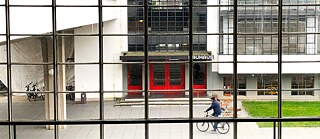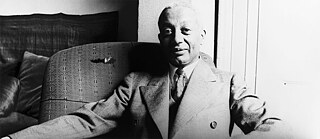Defining Design
100 Years of the Bauhaus
The Bauhaus school of art, architecture and design was founded in 1919 and only lasted for 14 years before the Nazis closed its doors. A century later, it still has an outsized influence in modern design around the world.
Listen to this episode: Apple Music | Spotify | Download
This episode is by Verónica Zaragovia. Verónica lived and worked in Berlin for several years. As a Pulitzer Center grantee, she told multimedia stories from all over the world. In this podcast, Verónica talks with architecture experts from the U.S. and Germany and visits museums in Weimar, including the Bauhaus Dessau Foundation. The music in this episode is from Blue Dot Sessions. Verónica took the photo of the facade of the Bauhaus building in Dessau for the episode.
Transcript
Verónica Zaragovia: I’m Verónica Zaragovia in Berlin. At the heart of this episode is a story of triumph over evil. It’s about the Bauhaus. A school of arts, design and architecture that opened 100 years ago in Germany. You see, the Nazis are the reason the Bauhaus operated in Germany for just 14 years. They didn’t like the art and design movement because it was avant-garde and utopian. Because some of its members had ties to the Soviet Union or to communists, others were Jewish. The Nazis did manage a short-term victory over the Bauhaus. They pressured the school to either adopt Nazi curriculum or close down. So the Bauhaus shuttered its doors in 1933. At least half of the instructors and students fled Germany. But the students and teachers who left ... spread Bauhaus designs and helped it flourish around the world including the U.S. and Israel. Like in Tel Aviv [SOUND OF A TEL AVIV STREET] — a city I lived in for about a year after college. About four thousand Bauhaus-influenced buildings — designed by Jewish architects, some who’d studied at the Bauhaus — dot the city. They have flat roofs, balconies and simple straight or curvy lines. Join me as I talk with experts to find out what Bauhaus and its buildings are all about.
[SOUND OF US WALKING AND TALKING]
Verónica Zaragovia: This here you would say, we’re in like the center of Weimar?
Wolfgang Holler: No, this is not the center but that is the Frauenplan, the place where the Goethe Haus stands ...
Verónica Zaragovia: I’m walking with Wolfgang Holler. He’s the director of the museums in Weimar, a small city in central East Germany that he loves ...
Wolfgang Holler: ... one of the most important places in Germany, I think, so I’m always very proud when I say, “What is your address?” Frauenplan 1. That is a very famous address ...
Verónica Zaragovia: It’s long been associated with high culture. The composer Bach once lived here. So did the philosopher Nietzsche. Streets are clean. It has quaint open squares. Most buildings have slanted German roofs.
Wolfgang Holler: [LAUGHS] Perhaps this is the most fascinating place, next to Goethe. Because this is the place where the German constitution after the First World War was set up. And that was in this theater over there, the National Theater — the name National Theater shows that we think it’s an important theater, it’s perhaps not the best ...
Verónica Zaragovia: We’re standing in front of a statue of famed German authors Goethe and Schiller. It’s in front of the German National Theater, where Germany adopted a new constitution just after the First World War ended. The war destroyed Germany’s economy. One German architect — Walter Gropius — who had fought in this war, had a vision to reshape German society. To make it more fair. In 1919, he gets a chance to create something new and inspiring: an arts school in Weimar. He calls it the Bauhaus ... or the house of building.
Wolfgang Holler: The idea of Gropius was a very social one, it was a political one. It was not only art, but it was always situated in the context of community, of society. And he said this old world is gone and we have to build up a new world.
Verónica Zaragovia: He even wrote a manifesto, which rejected art as a luxury. He wrote, “The ultimate aim for all creative activity is the building.” He called for equality between artists and craftspeople. Later on, Gropius fused art and technology. All of its students had to take a preliminary course …
Jordan Troeller: Where you learn about color and form and materials and principles of design and you learn by experimenting with these in a studio.
Verónica Zaragovia: Jordan Troeller, originally from the U.S., and a professor in Berlin and Bauhaus expert, explains the Bauhaus rejected the kind of education you’d get at the École des Beaux Arts in France, where students learned by copying old masterworks.
Jordan Troeller: ... which the Bauhaus was extremely critical and vocal about doing away with.
Verónica Zaragovia: Then they could take other workshops, like metal work, wall painting, ceramics, printing, stained glass and theater. I should point out that although the Bauhaus admitted many women, barely any got to be ‘masters’ — the term for teachers. They mostly learned weaving. Gropius brought big names from around Europe to join his school. Artists like Wassily Kandinsky, Marcel Breuer, László Moholy Nagy, Josef Albers and Paul Klee.
Wolfgang Holler: And they all came here and were very hippy-like.
Verónica Zaragovia: Holler means hippies in an early 20th century kind of way. They had kite and lantern festivals and parties on the weekends. They didn’t have to wear collars or stockings. Some had long hair others shaved their heads. They were also promiscuous.
Wolfgang Holler: And, and, and the people were enraged. They thought this was impossible to have them here.
Verónica Zaragovia: When the Bauhaus started, Weimar had a more liberal government. But it tilted right over the years, and funding for the Bauhaus eventually got cut. In 1925 the school’s staff and students were sent packing.
❡
[INSIDE A TRAIN SOUND, ARRIVING IN DESSAU, ANNOUNCEMENT IN GERMAN]
Verónica Zaragovia: The school moved to Dessau. At first, this industrial city about 70 miles southwest of Berlin welcomed them. The city even commissioned an iconic Bauhaus building that housed the school. From the outside, it looks like a gray rectangle with red doors and lots of windows. It has the letters B-A-U-H-A-U-S stacked vertically on one wall. The Bauhaus even had its own typography. Letters look slightly rounded and they don’t have serifs — those end lines in some fonts at the bottom of an H or in a capital E. Today this building is the Bauhaus Dessau Foundation. Florian Strob, a researcher here, pulls a chain that opens some windows.
[SOUND OF CHAINS BEING PULLED. AND THEN THE SOUND OF THE MECHANISM TO OPEN AND CLOSE THE WINDOWS IN THE STAIRCASE.]
Florian Strob: It’s a chain.
Verónica Zaragovia: And the windows are opening.
Florian Strob: Yeah the windows are opening. A whole row of windows. I’m going to close it again because it’s cold outside.
Verónica Zaragovia: By pulling on these chains, the panels of the windows turn 180 degrees inwards. Then they can be washed from the inside. The Bauhaus was into utilitarianism. From this point on Gropius became focused on affordable housing and mass production. Lots of people have made a connection between the Bauhaus and Ikea. Instead of being round [Sound of door knob], door knobs resemble a sideways letter L.
Florian Strob: These are the typical Gropius handles, designed by Gropius. And you can hear the echo in the corner. [SOUND OF STROB’S ECHO]
Verónica Zaragovia: Rooms have high ceilings and decoration is minimal.
Florian Strob: You can probably hear the echo of this room. That’s because of the bare walls and the concrete and so forth. But it’s not only concrete, it’s a lot of different materials, like linoleum partly for the flooring, or the metal of the window frames and so forth. You really have to pay attention. It’s kind of a building — at least the Bauhaus building — for all the senses.
Verónica Zaragovia: Bauhaus designers wanted nothing to do with fancy ornamentation around windows and doorways. They liked flat roofs. They preferred practical, yet sleek designs.
Florian Strob: These people were brave. They were brave enough to try to find a new expression for their own time to express their time, the industrial age after the First World War, with a new design, new architecture. And at least what you see a lot in Germany I think and all over the world is: we’re kind of missing that. We could be dreaming a little more.
[MUSIC]
[SOUND OF TOUR]
Jeanne Colgan: It was very important for students to have a canteen because many of them were very poor. You’re talking about poor starving students, they were. And so the canteen supplied them with cheap meals to fill them up, for example potatoes and sauce.
Verónica Zaragovia: After speaking to Strob, I join a group tour given by Jeanne Colgan, originally a New Yorker.
Jeanne Colgan: This table is 80 centimeters high, so a little bit higher, ok. So when I sit down I’m encouraged to sit up straight to eat my food. And by sitting up straight I don’t need the back of a chair. So with that we could have these lovely light-weight stools, less material. Elegantly put under the table. So you have form and function at the same time. Every single detail was thought about in the Bauhaus.
Verónica Zaragovia: She shows us the rooms of this legendary Bauhaus campus including the old student dorms that now serve as hotel rooms for tourists.
Unidentified Voice: At this time you can stay here?
Jeanne Colgan: You can stay here. You can book a room.
Man: Yes?
Jeanne Colgan: Yes.
Man: You know how much is it?
Jeanne Colgan: Like 60 Euros or so. It’s not expensive. There’s no breakfast. It’s very bare, but ...
Verónica Zaragovia: Colgan reiterates that the Bauhaus was not into showy architecture.
Jeanne Colgan: The Bauhaus didn’t invent this style of architecture. It was part of a movement — Neues Bauen, new building at the time. In the early 20th century. The First World War was over. 10 million people had been killed. Technology had been developed. Sometimes wars do that, new technology was developed. And new building materials were available.
Verónica Zaragovia: ... materials like concrete, glass and steel.
[MORE SOUND OF CHAINS TO OPEN WINDOWS]
Verónica Zaragovia: The Bauhaus glorified the industrial technology of the time — take the radiators ...
Jeanne Colgan: ... and here if you see the radiators. It’s kind of strange where they are. They’re up high on the wall. It doesn’t really make sense. Normally your radiators are down low. It’s a bit of a joke. It’s the same in the auditorium where we just were. In the back of the auditorium the radiators are up high. Instead of having the portrait of the founder of the Bauhaus or paintings from all these masters who were here ... it’s ... tada! Technology. This is our art. So I think it’s a great joke. Doesn’t really make sense ...
Verónica Zaragovia: The Bauhaus school proclaimed form follows function. Everything they designed had a practical purpose.
Jeanne Colgan: ... now Gropius himself was interested in the flat roof for design reasons. And he even had a survey in an architectural magazine at the time asking other renowned architects what you think of the flat roof. And he was convinced. One was the style, also another factor was that the whole building can be used. Normally with a gable roof you can’t use the attic so well. Also there was less fire hazard. And of course the aesthetic, and also that water could be drained, because it’s going toward the middle interior and you wouldn’t have gutters or downspouts outside affecting the design. Plus, for example on the studio part you could use the roof for exercises and for parties and all.
❡
[MUSIC]
Jordan Troeller: People at the Bauhaus themselves placed a huge emphasis on architecture as the mother of all the arts.
Verónica Zaragovia: Here’s Jordan Troeller again.
Jordan Troeller: Because the building would contain all kinds of crafts like, you know, textiles within an interior, furniture design, stained glass window, of course paintings and photographies hanging on the wall. So they thought about the building as being a vessel for all these different ways of producing artistic objects. Sometimes they would take the flooring and curve it up slightly onto the wall so that the mop would be able to get all of it and not like encounter this hard edge where dirt would get stuck in the corner.
Verónica Zaragovia: Things weren’t always smooth-going at the Bauhaus. Tempers flared, teachers and directors came and left. The school had three directors over its 14 years. When the Nazi Party gained strength in Dessau’s state government, the school’s reputation started to diminish. Newspapers criticized it, critics called the teachers and students communist sympathizers. In the summer of 1932, the Nazi party forced the Bauhaus out. So it packed up and moved again. This time to Berlin. The school reopened in an empty telephone factory and the famed architect Mies van der Rohe took over. Not long after, police searched the building. Students were arrested and the school closed under Nazi pressure. People fled, especially if they were Jewish. Or identified with leftist ideology. Or really for any and all of the reasons an artist would escape a dictatorship. They fled to different countries, many to the U.S.
Wolfgang Holler: I think without America, the Bauhaus wouldn’t be what it is today. Or what we think that it is today. Finally it is an idea, it is not the historic Bauhaus anymore.
Verónica Zaragovia: That’s Wolfgang Holler again, our Weimar expert. In the U.S. the Bauhaus garnered lots of attention. There was a 1938 exhibit at the Museum of Modern Art in New York. The school’s founder, Walter Gropius taught architecture at Harvard University. Two of the major Bauhaus figures went to Chicago. Bauhaus legends have designed buildings in states like Massachusetts, Illinois, Michigan and New York. But on the 100th anniversary of the Bauhaus, the attention on the school is largely in Germany.
Wolfgang Holler: And we are very hard working to show that the Bauhaus comes from Weimar, it was founded here. And that was a really very important ... it was the initiation of the Bauhaus and it was perhaps the most — wie sagt man? — vivid time!
Verónica Zaragovia: In Weimar, a new Bauhaus museum recently opened. Wolfgang Holler shows me that it’s across from a big Nazi-era hall called the Gauforum.
Wolfgang Holler: It’s really brutal but great, enormous building of the Gauforum of the 30s, which was not — wie sagt man es? Beendet, nicht vollendet — it was not ...
Verónica Zaragovia: Finished?
Wolfgang Holler: Finished. It was not finally, not finished but it’s the most perfect Gauforum in Germany. It’s very ugly but it was to show the attitudes of this new system. And to have big assemblies of people. There’s a hall, the hall of the Volk ... the Volk’s hall.
Verónica Zaragovia: The Nazis coordinated forced labor there.
Wolfgang Holler: Really next to this building of the Bauhaus. So we really have these — wie sagt man — Antipodes.
Verónica Zaragovia: It really is right next to it.
At this new museum they plan to host political discussions and invite Germany’s new right-wing party — the Alternative für Deutschland. It’s a party full of controversy. One senior leader said Germany’s politics of Holocaust remembrance cripples the country. The party disparages Muslim immigrants. Holler hopes they’ll come talk to people here with opposing views.
[MUSIC]
❡
Verónica Zaragovia: Back in Berlin, architect Robert Huber is working on another space for dialogue, this one using old Bauhaus materials. His project is called “Bauhaus reuse.” They’re reusing windows that used to be on the north facade of Dessau’s Bauhaus building we visited earlier. These windows were taken down in 2011 and replaced.
Robert Huber: This makes people aware of thinking how to deal with modern heritage, like, how to deal with heritage in general. Of course there’s always this decision to make if something gets old, if something is outdated how do we deal with it? Do we throw it away? Is it worth it to refurbish?
Verónica Zaragovia: We’re standing on a roundabout, with cars driving by.
Robert Huber: On that square we’re allowed to be guests for some years with our project “Bauhaus re use.”
Verónica Zaragovia: Here?
Robert Huber: Here, on the place where you can see here in the background. Be careful, there’s a care coming, it’s from the construction site.
Verónica Zaragovia: Here in the middle of it, students are building a glass pavilion.
[CONSTRUCTION NOISE]
Robert Huber: The Bauhaus re use idea it goes further so that it’s also like the construction like we do it now with apprentices, it’s following the Bauhaus idea. In the sense of that we bring together people on the construction site — the Bauplatz, like Gropius said — and that they really, you know, get a very broad understanding of material, of architecture, of construction, of the different aspects of design. Yeah, they get a practical experience and that’s very important. And also for us it’s very important to bring together students and apprentices like the Bauhaus basically did, yeah ...
Verónica Zaragovia: Once the pavilion is ready, Huber says they’ll host discussions on topics like urban planning, sustainable architecture and the Bauhaus. One hundred years later it really feels like the Bauhaus never left Berlin.







